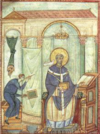Quizzes Flashcards

Melismatic
Which of the following Mass movements is the most elaborate?
- Alleluia
- Credo
- Agnus Dei
- Sanctus
Which of the following Mass movements is the most elaborate?
- Alleluia
The liturgy is the music of the medieval church service.
True or False
The liturgy is the music of the medieval church service.
False
What is the form of a hymn?
What is the form of a hymn?
strophic
Which of the following services is the longest?
- Lauds
- Prime
- The Mass
- Terce
Which of the following services is the longest?
- The Mass
Which service consists of the performance of Psalms and Hymns?
Which service consists of the performance of Psalms and Hymns?
The Services of the Office The Mass
How is responsorial chant performed?
How is responsorial chant performed?
A soloist alternates with choir. The choir responds to the singing of the soloist.

Syllabic
The Mass is performed by priests alone. The congregation, while they may watch and listen, is not involved at all.
True or False
The Mass is performed by priests alone. The congregation, while they may watch and listen, is not involved at all.
False
What is a jubilus?
A jubilus is an extended melody on the final syllable of a chant.
What are the three different types of chant performance?
- direct
- antiphonal
- responsorial
What is an antiphon?
An antiphon is a short piece performed both before and after a Psalm. The proper text of the antiphon relates the text of the Psalm to the feast of the day.
What are the three different styles of chant?
- syllabic
- neumatic
- melismatic
How is antiphonal chant performed?
Two choirs sing back and forth with one another
What is the difference between the ordinary and proper movements of the Mass?
The ordinary includes texts that are the same every single day while the proper texts change to suit the feast of the day.



